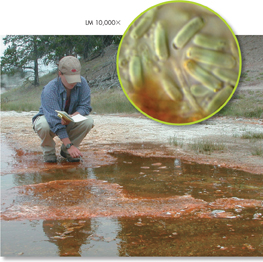Homologous Molecules In Darwin's day, biologists could only study similarities and differences in structures they could see. But physical body structures can't be used to compare mice with yeasts or bacteria. Today, we know that homology is not limited to physical structures. As shown in Figure 16–16, homologous proteins have been found in some surprising places. Homologous proteins share extensive structural and chemical similarities. One homologous protein is cytochrome c, which functions in cellular respiration. Remarkably similar versions of cytochrome c are found in almost all living cells, from cells in baker's yeast to cells in humans.
There are many other kinds of homologies at the molecular level. Genes can be homologous, too, which makes sense given the genetic code that all plants and animals share. One spectacular example is a set of ancient genes that determine the identities of body parts. Known as the Hox genes, they help to determine the head-to-tail axis in embryonic development. In vertebrates, sets of homologous Hox genes direct the growth of front and hind limbs. Small changes in these genes can produce dramatic changes in the structures they control. So, relatively minor changes in an organism's genome can produce major changes in an organism's structure and the structure of its descendants. At least some homologous Hox genes are found in almost all multicellular animals, from fruit flies to humans. Such profound biochemical similarities are best explained by Darwin's conclusion: Living organisms evolved through descent with modification from a common ancestor.

FIGURE 16–16 Similar Genes Bacteria in this hot spring live in near-boiling water—an inhospitable environment to animals. Their cells even look different from animal cells. Yet many of their genes, and therefore the proteins coded by those genes, are similar to those of animals. This is more evidence that all organisms share an ancient common ancestor.
Testing Natural Selection
 What does recent research on the Galápagos finches show about natural selection?
What does recent research on the Galápagos finches show about natural selection?
One way to gather evidence for evolutionary change is to observe natural selection in action. But most kinds of evolutionary change we've discussed so far took place over millions of years—which makes it tough to see change actually happening. Some kinds of evolutionary change, however, have been observed and studied repeatedly in labs and in controlled outdoor environments. Scientists have designed experiments involving organisms from bacteria to guppies to test Darwin's theories. Each time, the results have supported Darwin's basic ideas. But one of the best examples of natural selection in action comes from observations on animals living in their natural environment. Fittingly, those observations focused on Galápagos finches.
A Testable Hypothesis Remember that when Darwin first saw the Galápagos finches, he thought they were wrens, warblers, and blackbirds because they looked so different from one another. Once Darwin learned that the birds were all finches, he hypothesized that they had descended from a common ancestor.
Table of Contents
- Formulas and Equations
- Applying Formulas and Equations
- Mean, Median, and Mode
- Estimation
- Using Measurements in Calculations
- Effects of Measurement Errors
- Accuracy
- Precision
- Comparing Accuracy and Precision
- Significant Figures
- Calculating With Significant Figures
- Scientific Notation
- Calculating With Scientific Notation
- Dimensional Analysis
- Applying Dimensional Analysis




